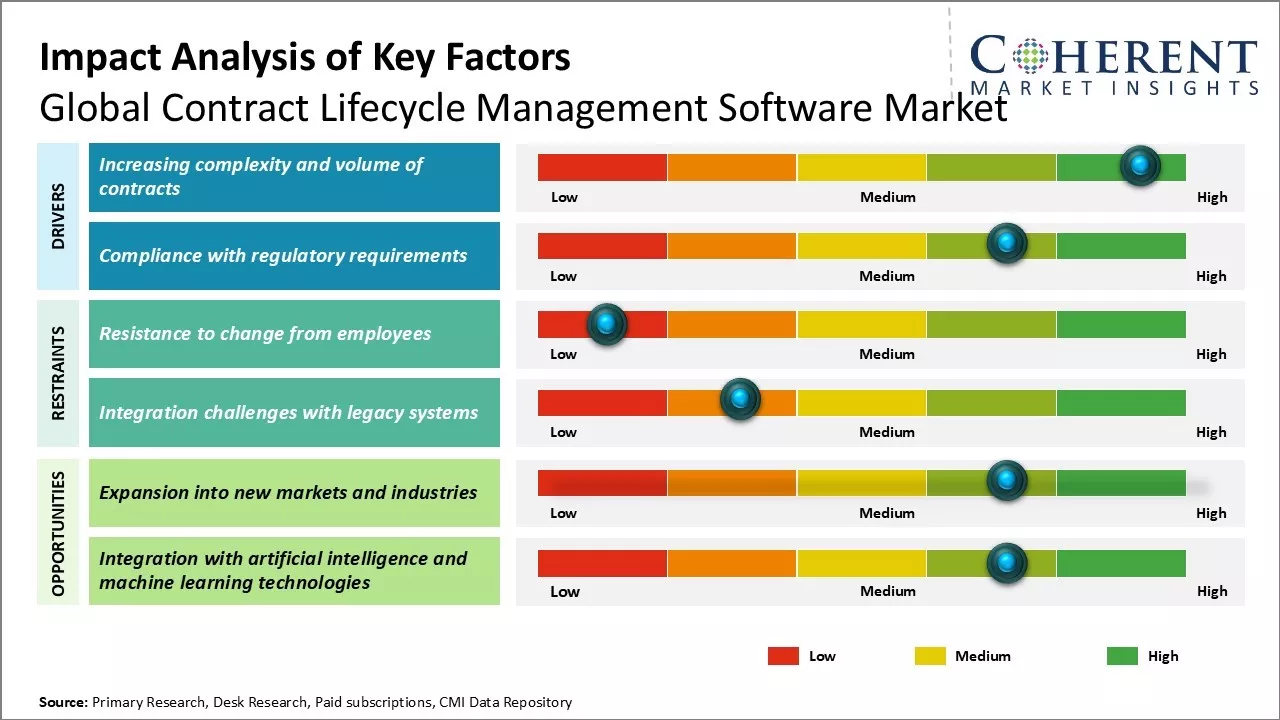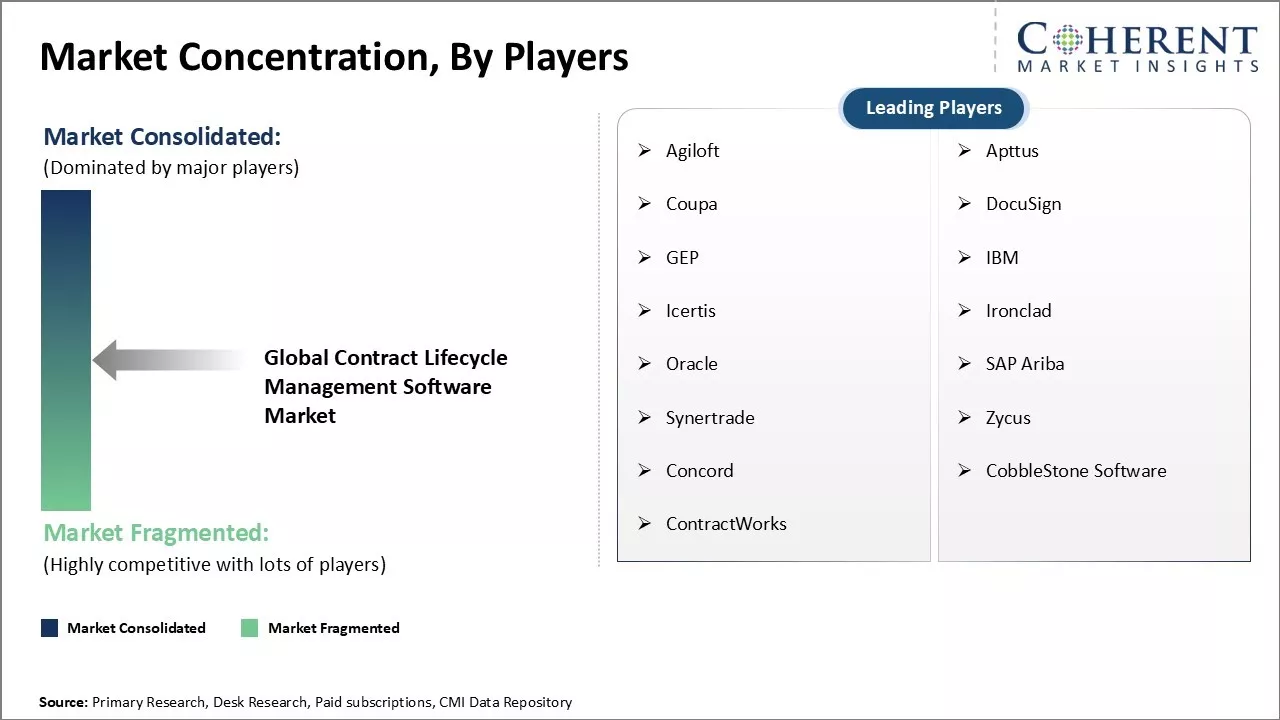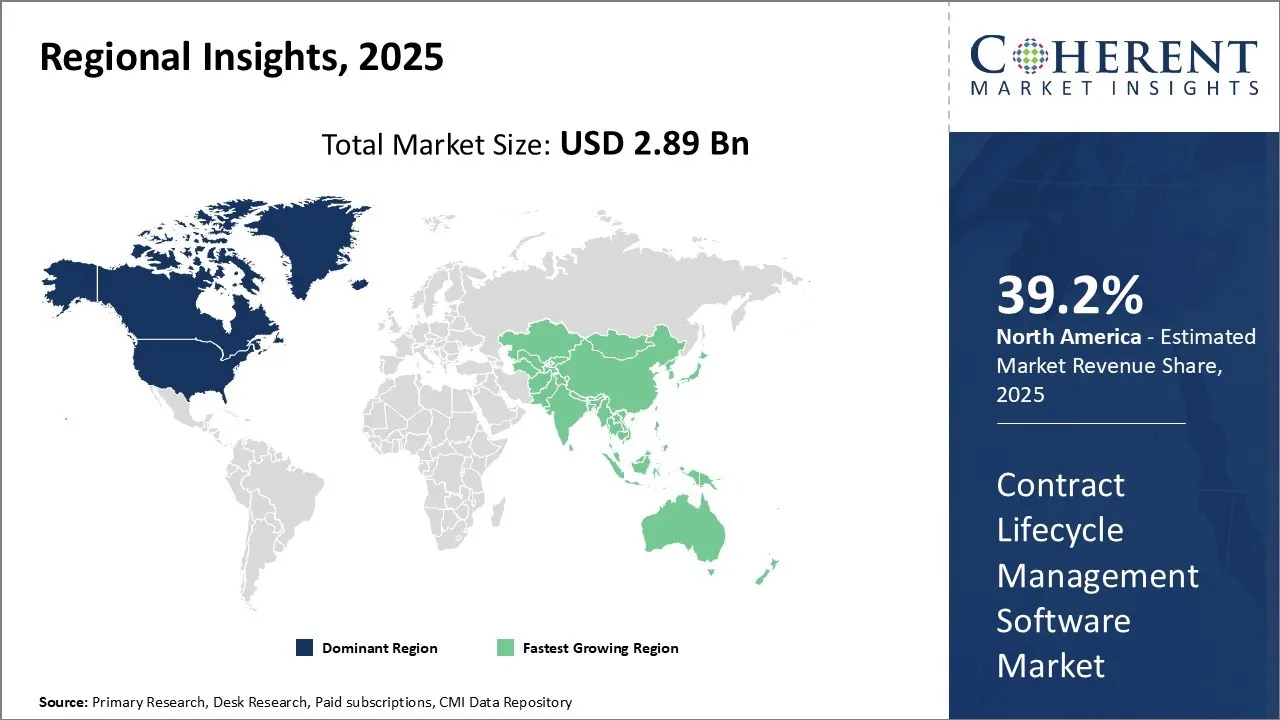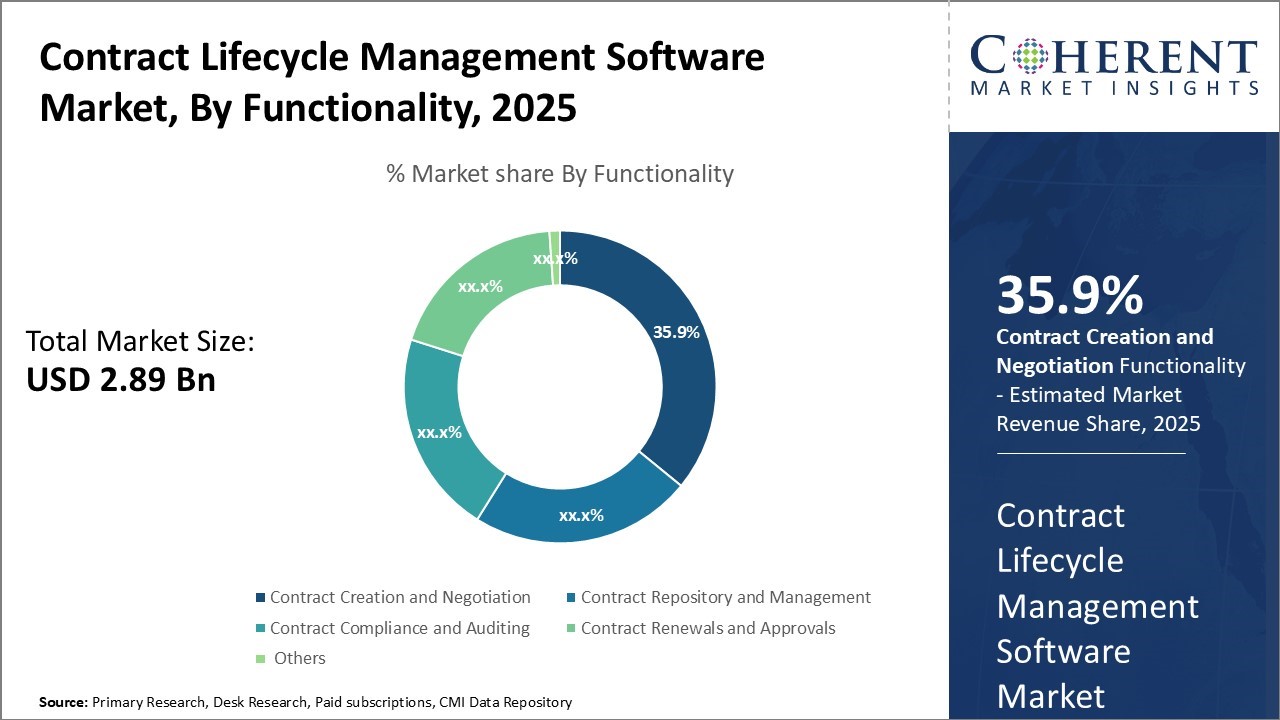Global Contract Lifecycle Management Software Market Size and Forecast 2025-2032
The Global Contract Lifecycle Management Software Market is estimated to be valued at USD 2.89 Bn in 2025 and is expected to reach USD 6.81 Bn by 2032, exhibiting a compound annual growth rate (CAGR) of 13.0% from 2025 to 2032.

To learn more about this report, Download Free Sample
Key Takeaways Global Contract Lifecycle Management Software Market
- In terms of functionality, the contract creation and negotiation segment is estimated to hold 35.9% share of the global contract lifecycle management software market in 2025.
- In terms of deployment mode, the cloud-based segment is estimated to hold 41.7% share of the global contract lifecycle management software market in 2025.
- In terms of vertical, the BFSI segment is estimated to hold 40% share of the global contract lifecycle management software market in 2025.
- North America has established itself as the dominant region in the global contract lifecycle management software market with an estimated 39.2% share in 2025.
Market Overview
The Global Contract Lifecycle Management (CLM) Software Market is experiencing significant growth, due to the increasing demand for automation in contract processes across enterprises. As organizations aim to reduce legal and compliance risks, improve contract visibility, and enhance operational efficiency, the adoption of CLM software has become a strategic priority. The market is being driven by sectors like BFSI, healthcare, IT, and manufacturing, where managing complex contracts is crucial. Cloud-based deployment models are gaining popularity, due to their scalability and ease of integration with existing enterprise systems. With rising regulatory requirements and global expansion of businesses, CLM software is emerging as a critical tool for ensuring contract governance and performance.
Impact of AI on the Global Contract Lifecycle Management Software Market
The integration of artificial intelligence is revolutionizing the contract lifecycle management software market by driving unprecedented efficiency, risk mitigation, and strategic value across legal and commercial operations.
- Concord has successfully implemented AI, enhancing its CLM platform with AI-driven contract analytics and automation tools. Their solution combines Natural Language Processing for rapid clause extraction with predictive analytics to flag high-risk terms. Legal teams using Concord's AI-powered CLM report 80% faster contract processing and a 40% reduction in missed renewals, while finance departments leverage these capabilities to optimize discount structures and prevent revenue leakage.
- Icertis specializes in contract lifecycle management (CLM) through its advanced technology, notably the AI-driven Icertis Contract Intelligence (ICI) platform. This platform transforms contracts from static documents into strategic assets by structuring and connecting contract data.
Current Events and Its Impact
|
Current Events |
Description and its impact |
|
Regulatory Compliance Shifts |
|
|
Technological Disruptions |
|
Uncover macros and micros vetted on 75+ parameters: Get instant access to report
Market Trends
Increasing Complexity and Volume of Contracts
As organizations expand their operations globally and undertake diverse business ventures, the complexity and volume of contracts they deal with increases manifolds. Contracts are no longer simple agreements but intricate documents involving various clauses, provisions, appendices catering to different regulatory landscapes and stakeholder needs. Managing this deluge of contractual information manually is an onerous task prone to errors. Any oversight can lead to severe financial and legal repercussions. Traditional document management systems struggle to keep pace with this evolution and ensure regulatory conformity.
Contract lifecycle management software provides the structure and workflows necessary to systematically deal with contractual data overload. It offers centralized repositories to store all agreements in a consistent format, with value-added features like version control, retrieval, tracking expiration dates. The contract drafting and review process is streamlined with customizable approval workflows. Flexible templates address varying needs while ensuring compliance. Additionally, AI and machine learning are being used to enhance manual reviews and provide valuable insights.
Compliance with Regulatory Requirements
The regulatory compliance is vital for contracts; non-adherence brings severe penalties and reputational damage. With regulations constantly evolving, manual processes struggle to keep up. Contract Lifecycle Management (CLM) platforms address this by centralizing regulatory knowledge, standardizing contract templates and workflows, and using automated audits to ensure compliance. Advanced CLM, enhanced by AI and analytics, scans past contracts to recommend risk-optimizing additions and even predicts future non-compliance, ensuring organizations stay perpetually compliance-ready and agile in negotiations as the regulatory landscape deepens.
Market Concentration and Competitive Landscape

To learn more about this report, Download Free Sample
Analyst View
- The true innovation in CLM lies in AI-powered tools that automate sophisticated tasks like real-time risk detection and precise obligation tracking. To illustrate, Icertis utilizes machine learning to flag contract anomalies, enabling Fortune 500 companies to proactively manage vast numbers of supplier agreements. This capability far surpasses the limitations of traditional ERP systems, transforming contract management into a predictive and strategic function.
- Integration is the decisive factor for CLM adoption and sustained value. Platforms that seamlessly sync with major enterprise systems such as Salesforce, SAP, or Microsoft Dynamics achieve higher renewal rates and deeper market penetration. Conversely, standalone CLM tools struggle with user retention, as they fail to embed effectively into the existing digital ecosystems where legal and procurement teams already operate, creating friction and hindering efficiency.
Market Opportunity: Expansion into New Markets and Industries
The global contract lifecycle management software market has a huge opportunity for expansion into new markets and industries. Currently, major users of these solutions include IT & telecom, government, healthcare, and BFSI sectors. However, with growing digitization across all business functions, there is immense scope for contract lifecycle management software providers to target newer application areas. Industries like manufacturing, energy & utilities, retail, and media & entertainment are increasingly realizing the need to manage contracts electronically.
Regions like Asia Pacific, Latin America, and Eastern Europe offer a substantial greenfield opportunity with early stage of technology adoption. Software vendors can gain first mover’s advantage in these emerging territories. Additionally, penetrating small and medium enterprises worldwide presents a large untapped market segment. Focusing on specific industry and geographical diversification will help drive next phase of growth for contract lifecycle management software market players globally.
Global Contract Lifecycle Management Software Market Insights, By Functionality - Contract Creation and Negotiation Segment is Driving Complex Contract Processes
In terms of functionality, the contract creation and negotiation segment is estimated to hold 35.9% share of the global contract lifecycle management software market in 2025. This segment deals with the initial stages of contract creation and management of related negotiation processes between various stakeholders.
Automation tools in CLMS platforms have significantly streamlined these processes by enabling template-based drafting, assigning negotiation roles, approval workflows, and version control within a centralized system. These features bring greater transparency, reduce manual errors, and ensure all changes are properly documented. With increasing contract complexity across industries and a growing share of remotely negotiated deals, the demand for advanced CLMS solutions in this segment continues to rise.
Global Contract Lifecycle Management Software Market Insights, By Deployment Mode: Growth Driven by Rising Adoption of Cloud-Based Solutions
In terms of deployment mode, the cloud-based segment is estimated to hold 41.7% share of the global contract lifecycle management software market in 2025. CLMS solutions deployed over cloud infrastructure have seen widespread adoption in recent times owing to various operational advantages. Transitioning contract management processes to cloud removes the hassles of expensive on-premise installations, reductions in upfront capital expenditure and lowers the costs associated with periodic software/hardware upgrades.
Cloud-based CLMS platforms are easily accessible via any internet-enabled device, allowing improved mobility and collaboration. Their subscription-based payment models prove more cost-effective for smaller teams or firms that do not require high-computing installations. Furthermore, CLMS vendors can seamlessly roll-out new features and updates on cloud platforms, eliminating downtimes for software upgrades. This has ensured cloud-deployed solutions always remain up-to-date with the latest technologies and regulatory changes.
Global Contract Lifecycle Management Software Market Insights, By Vertical: BFSI Segment is Leading Regulated Contracts
In terms of vertical, the BFSI segment is estimated to hold 40% share of the global contract lifecycle management software market in 2025. The sector handles highly regulated contracts involving loans, policies, and investment plans, where mismanagement can lead to major compliance and financial risks. CLMS platforms help BFSI firms centrally govern contract data, manage version histories, enforce authorization controls, and automate workflows for audits and renewals. Advanced analytics assist in identifying risks and reducing turnaround times. With rising regulatory pressure and the critical nature of contracts, BFSI institutions are increasingly adopting CLMS to streamline operations and support their digital transformation efforts.
Regional Insights

To learn more about this report, Download Free Sample
North America Contract Lifecycle Management Software Market Trends and Analysis
North America has established itself as the dominant region in the global contract lifecycle management software market with an estimated 39.2% share in 2025. This can be attributed to the strong presence of major technology companies and early adoption of new technologies.
Contract management is a crucial process for companies operating across industries in North America. Organizations rely heavily on integrated software suites to efficiently handle documentation, collaboration, and compliance requirements throughout the contract lifecycle. A highly skilled workforce and advanced infrastructure supports implementation of sophisticated CLM solutions.
Compared to other regions, pricing in North America tends to be on the higher side given the additional features and functionalities demanded by clients. For instance, in Q2 2025, DocuSign launched its Intelligent Agreement Management (IAM) platform including AI-powered contract agents to enhance contract workflows. The rollout delivered rapid traction among enterprise customers, supported by advanced analytics and CRM integrations, though specific industry engagements have not been formally disclosed.
Asia Contract Lifecycle Management Software Market Trends and Analysis
The Asia Pacific region has emerged as the fastest-growing market for CLM software in recent years, driven by rapid digitization and a strong push to streamline operations across enterprises. Countries like China, India, and Australia are leading adoption due to industrial expansion and increased global engagement.
The region's role as a hub for outsourced legal and consulting services has also boosted demand for CLMS implementation. Competitive talent availability makes it attractive for global vendors, despite longer sales cycles due to detailed evaluations. Economic growth, urbanization, and a tech-savvy demographic are further fueling the region’s momentum in contract management transformation. For example, Infosys BPM has launched its next-gen CLM tool, centralizing contract workflows and embedding AI/ML to streamline negotiations, repository management, and compliance across global clients.
Contract Lifecycle Management Software Market Outlook for Key Countries
U.S. Contract Lifecycle Management Software Market Trends
The U.S. Contract Lifecycle Management (CLM) software market is experiencing significant growth, driven by an increasing need for automation, efficiency, and risk mitigation in contract management. The market is projected to expand considerably in the coming years, with North America, particularly the U.S., holding a dominant share, due to rapid technological advancements and a complex regulatory environment. For instance, the widespread adoption of cloud-based CLM solutions is a major trend, expected to account for over 70% of the market share in 2024, offering scalability and accessibility.
China Contract Lifecycle Management Software Market Trends
China’s CLM software market is growing swiftly, fueled by the widespread adoption of cloud technologies, AI-powered tools, and strong regulatory support for digital contracting. Major industries increasingly rely on CLM platforms to manage complex supplier agreements and ensure compliance. The government's push for digital governance and the Electronic Signature Law have accelerated demand for these solutions.
Local tech giants like Alibaba Cloud and Huawei Cloud are playing a key role in providing scalable infrastructure. Domestic vendors are also expanding their offerings with e-signature and automation features to meet enterprise needs. For instance, Chinese firms such as Yonyou and Weaver have strengthened their CLM platforms with cloud-based architecture and AI features to meet rising enterprise demand. Additionally, over 50% of large Chinese companies now use CLM tools to manage contract risks and improve visibility. Government policies requiring digital contract systems for public-sector entities by 2025 further boost adoption.
Germany Contract Lifecycle Management Software Market Trends
Germany’s contract lifecycle management software market is fueled by its industrial sector’s need for secure and compliant contract management. Rising adoption of cloud‑based Contract Lifecycle Management Software platforms enables remote collaboration and integration with ERP systems.
German firms are also emphasizing data sovereignty and GDPR compliance, seeking customizable solutions tailored to industry-specific requirements. For instance, local providers are delivering specialized Contract Lifecycle Management Software modules for the automotive and manufacturing verticals, helping firms maintain compliance and improve supplier contract oversight.
Japan Contract Lifecycle Management Software Market Trends
Japan’s CLM software market is growing steadily, driven by the need to modernize contract processes in sectors like manufacturing, finance, and electronics. Organizations are adopting AI-enhanced CLM tools to automate drafting, negotiation, and post-signature workflows. These tools are increasingly integrated with ERP systems to ensure better contract visibility, compliance tracking, and risk management.
In April 2024, LegalOn Technologies announced a strategic alliance with Mori Hamada & Matsumoto, confirming that legal content such as templates and guidance for M&A and international transactions would be available on its LegalOn Cloud platform by summer 2024.
Kozuchi, Fujitsu’s proprietary generative AI platform, is built for secure private-cloud deployment and offers advanced capabilities such as enterprise-grade natural language processing (NLP), analytics, AutoML, and Trust/XAI tools—specifically tailored for contract processing and wider digital transformation initiatives within enterprises.
End User Feedback and Unmet Needs
End user feedback
- Many users feel that the interface of CLM software is not user-friendly, making it difficult to navigate and reducing overall productivity.
- Users often report that integrating the CLM system with other enterprise tools like CRM or ERP is complicated and time-consuming.
- The AI-powered features such as clause extraction or risk detection are seen as inconsistent and not reliable enough for critical contract decisions.
Unmet needs
- Users want more efficient real-time collaboration tools within the CLM platform to work seamlessly with internal teams and external partners.
- There is a need for higher flexibility in designing contract workflows to match unique business rules and approval structures.
- Organizations are looking for more advanced compliance and audit features, especially proactive alerts to prevent contract breaches.
Market Report Scope
Contract Lifecycle Management Software Market Report Coverage
| Report Coverage | Details | ||
|---|---|---|---|
| Base Year: | 2024 | Market Size in 2025: | USD 2.89 Bn |
| Historical Data for: | 2020 To 2024 | Forecast Period: | 2025 To 2032 |
| Forecast Period 2025 to 2032 CAGR: | 13.0% | 2032 Value Projection: | USD 6.81 Bn |
| Geographies covered: |
|
||
| Segments covered: |
|
||
| Companies covered: |
Agiloft, Apttus, Coupa, DocuSign, GEP, IBM, Icertis, Ironclad, Oracle, SAP Ariba, Synertrade, Zycus, Concord, CobbleStone Software, and ContractWorks |
||
| Growth Drivers: |
|
||
| Restraints & Challenges: |
|
||
Uncover macros and micros vetted on 75+ parameters: Get instant access to report
Global Contract Lifecycle Management Software Industry News
- In May 2024, DocuSign finalized its USD 165 million acquisition of Lexion, adding advanced NLP and automated risk assessment to its cloud suite. The acquisition will bolster Docusign's position in Intelligent Agreement Management (IAM), a growing SaaS category, and will add more powerful AI capabilities to the Docusign IAM platform.
- In April 2024, DocuSign introduced the Intelligent Agreement Management platform, positioning the product as a new SaaS category centered on AI-orchestrated contracts.
- In June 2024, Conga launched a new Contract Lifecycle Management (CLM) product built on the Conga Platform.
- In January 2024, Evisort, an AI for contract lifecycle management (CLM) and analysis provider, launched Document X-Ray, offering organizations unprecedented access to their agreements.
- In April 2023, Icertis, a global leader in contract intelligence and lifecycle management, was selected by Krones AG, a prominent Germany-based packaging and bottling machine manufacturer, to implement its Icertis Contract Intelligence (ICI) solution at Krones' headquarters in Neutraubling, Bavaria. This partnership aims to streamline and unify contract lifecycle management processes, enhancing compliance with both buy-side and sell-side contract requirements in the packaging industry.
Emerging Applications
Few contract lifecycle management providers are leveraging predictive contract analytics to forecast contractual risks and opportunities, enabling proactive renegotiation strategies. This is a crucial, yet underutilized, application of artificial intelligence in contract lifecycle management, allowing businesses to analyze clause patterns and historical outcomes.
- The development of ethical artificial intelligence governance frameworks within contract lifecycle management tools, designed for bias detection and compliance auditing of artificial intelligence-generated clauses, remains a niche application.
- Companies in the contract lifecycle management (CLM) market are focusing on developing software applications to automate and streamline the entire contract lifecycle. For instance, in January 2024, a U.K.‑based company, Panoram, launched Panoram Contracts, a contract lifecycle management (CLM) application fully integrated with Microsoft 365, running natively inside Microsoft Teams, Outlook, and Word. This is designed to streamline contract workflows and enhance compliance and collaboration within familiar enterprise tools.
Market Segmentation
- By Functionality Insights (Revenue, USD Bn, 2020 - 2032)
- Contract Creation and Negotiation
- Contract Repository and Management
- Contract Compliance and Auditing
- Contract Renewals and Approvals
- Others (Reporting, Analytics, Workflow Automation, etc.)
- By Deployment Mode Insights (Revenue, USD Bn, 2020 - 2032)
- Cloud-Based
- On-Premises
- By Vertical Insights (Revenue, USD Bn, 2020 - 2032)
- BFSI
- IT and Telecommunications
- Manufacturing
- Retail and e-Commerce
- Healthcare and Pharmaceuticals
- Others
- By Regional Insights (Revenue, USD Bn 2020 - 2032)
- North America
- U.S.
- Canada
- Latin America
- Brazil
- Argentina
- Mexico
- Rest of Latin America
- Europe
- Germany
- U.K.
- Spain
- France
- Italy
- Russia
- Rest of Europe
- Asia Pacific
- China
- India
- Japan
- Australia
- South Korea
- ASEAN
- Rest of Asia Pacific
- Middle East
- GCC Countries
- Israel
- Rest of Middle East
- Africa
- South Africa
- North Africa
- Central Africa
- Key Players Insights
- Agiloft
- Apttus
- Coupa
- DocuSign
- GEP
- IBM
- Icertis
- Ironclad
- Oracle
- SAP Ariba
- Synertrade
- Zycus
- Concord
- CobbleStone Software
- ContractWorks
Sources
Stakeholders
- Contract Managers
- Procurement Heads
- Legal Advisors
- IT Decision Makers
- Others
Magazines
- CIO Magazine
- Contract Management Magazine
- Legaltech News
- Others
Journals
- Journal of Contract Management
- International Journal of Information Management
- Journal of Legal Studies
- Others
Newspapers
- The Wall Street Journal
- Financial Times
- The Economic Times
- Others
Associations
- International Association for Contract & Commercial Management (IACCM)
- National Contract Management Association (NCMA)
- Association of Corporate Counsel (ACC)
- Others
Public Domain Sources
- Company annual reports
- Government publications on procurement
- Press releases from software vendors
- Others
Proprietary Elements
- CMI Data Analytics Tool
- Proprietary CMI Existing Repository of information for the last 8 years
*Definition: The global contract lifecycle management software market consists of solutions that help organizations digitally negotiate, manage, and execute contracts from initiation through expiration. These solutions provide visibility into contracts across the entire lifecycle through automated workflows and notifications. They enable organizations to standardize contracting processes, accelerate contracting cycles, and ensure compliance with terms and obligations.
Share
Share
About Author
Ankur Rai is a Research Consultant with over 5 years of experience in handling consulting and syndicated reports across diverse sectors. He manages consulting and market research projects centered on go-to-market strategy, opportunity analysis, competitive landscape, and market size estimation and forecasting. He also advises clients on identifying and targeting absolute opportunities to penetrate untapped markets.
Missing comfort of reading report in your local language? Find your preferred language :
Transform your Strategy with Exclusive Trending Reports :
Frequently Asked Questions
EXISTING CLIENTELE
Joining thousands of companies around the world committed to making the Excellent Business Solutions.
View All Our Clients


